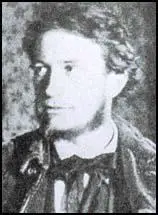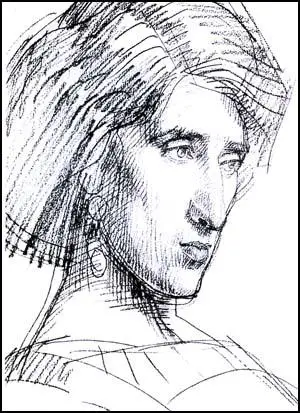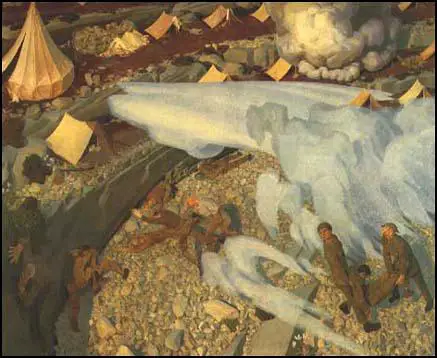Henry Lamb

Henry Lamb, the third son and fifth of the seven children of the mathematician, Horace Lamb was born in Adelaide, South Australia, on 21st June 1883. He was brought up in Manchester, where his father was professor of mathematics at the university.
Lamb was educated at Manchester Grammar School and four years at Manchester University Medical School, where he obtained a graduate scholarship in 1904. Despite this success, he abandoned medicine for painting and settled in London in the summer of 1905.
With the encouragement of his friend, Francis Dodd, he began his studies at the art school run by Augustus John and William Orpen in Chelsea in January 1906. Soon after arriving in the capital he met Lytton Strachey at a party. He told his friend, Leonard Woolf: "He's run away from Manchester, became an artist, and grown side-whiskers... I didn't speak to him, but wanted to, because he really looked amazing, though of course very bad." Strachey was a homosexual and made several unsuccessful attempts to seduce Lamb. One biographer has argued that Strachey was "convinced that Henry, with his angelic smile, his feminine skin and moments of incredible charm, could be converted to bisexuality".
Lamb was great influenced by his teacher, Augustus John. A friend commented: "He let his hair grow long; he failed to shave; he fastened on gold ear-rings... With his hypnotic deep-blue eyes he fascinated men and women alike, and his entrance into any gathering was almost as striking as that of his master (Augustus John)."
Lamb married Nina Forrest on 10th May 1906. According to Michael Holroyd: "Euphemia, as he called her, seemed the bohemian ideal of an artist's mistress model, with a natural sense of comedy and adventure. She lived through men, many of whom found her charming figure and husky voice, her oval face and honey-coloured hair, pnematically memorable." During this period he did occasional commissions from The Manchester Guardian for drawings of famous London buildings. In 1907 he continued his studies in Paris under Jacques-Émile Blanche. On his return he took a studio at 8 Fitzroy Street (1909–10).
Lytton Strachey introduced Lamb to what became known as the Bloomsbury Group, men and women who met to discuss literary and artistic issues. This group included Virginia Woolf, Vanessa Bell, Clive Bell, John Maynard Keynes, E. M. Forster, Roger Fry, Duncan Grant, Vita Sackville-West, Ottoline Morrell, Bertram Russell, Leonard Woolf, David Garnett, Desmond MacCarthy and Arthur Waley.
Another friend, Dorelia McNeill, introduced Lamb to Ottoline Morrell in 1909. The following year they began an intense affair. Ottoline wrote in May 1910: "It was perhaps a half maternal instinct that pushed me towards this twisted and interesting figure. Yet he was wonderfully attractive, sometimes like a vision of Blake, sometimes a version of Stendhal's Julien Sorel. I was in love with him... but all his heart is given to Dorelia (McNeill)."
According to Vanessa Curtis: "Lamb was an Adonis, with curly blond hair, a slim figure and a unique way of dressing in old-fashioned silk or velvet garments. He sported a gold earring and had a playful sense of humour. When he was in a good mood he proved an enchanting and alluring companion for Ottoline, but when he was depressed and bad-tempered, it took all of her natural patience and love to see them both through these difficult periods."

In 1910 Roger Fry, Clive Bell and Desmond MacCarthy went to Paris and after visiting "Parisian dealers and private collectors, arranging an assortment of paintings to exhibit at the Grafton Galleries" in Mayfair. This included a selection of paintings by Pablo Picasso, Henri Matisse, Paul Cézanne, Édouard Manet, Paul Gauguin, André Derain and Vincent Van Gogh. As the author of Crisis of Brilliance (2009) has pointed out: "Although some of these paintings were already twenty or even thirty years old - and four of the five major artists represented were dead - they were new to most Londoners."
This exhibition had a marked impression on the work of Lamb who joined forces with Augustus John, Percy Wyndham Lewis, Walter Bayes, Walter Sickert, Harold Gilman, Maxwell Gordon Lightfoot,, Spencer Gore, Lucien Pissarro, James Manson, Robert Bevan and Charles Ginner to form the Camden Town Group in 1911. Two years later this group merged with the Vorticists, to form the London Group. New members included Vanessa Bell, William Roberts, Stanisława de Karłowska and Paul Nash.
Lytton Strachey, who remained in love with Lamb, claimed that he was "a genius there can be no doubt, but whether a good or an evil one?" He added: "He is the most delightful companion in the world and the most unpleasant." Duncan Grant, another homosexual, got to know Lamb and told Strachey, "I'm convinced now he's a bad lot." Ottoline Morrell also complained about his aggressive moods of depression: "The more I suffered from it the more he delighted in tormenting me."
Lamb did a series of paintings of Breton subjects, such as Death of a Peasant (1911) and Lamentation (1911). According to the critic, Dennis Ashwell Farr: "In these paintings austere realism, a restrained palette, and striking, deceptively simple composition are qualities characteristic also of much of his later work." Farr goes onto argue that with the exception of Phantasy (1912), "a group of male nude equestrians perhaps inspired by the circus scenes of Picasso's rose period, Lamb seems to have been almost impervious to the revolutionary movements in contemporary French art."
On 25th January 1912 Lytton Strachey wrote to Ottoline Morrell: "He (Henry Lamb) has been charming, and I am much happier. I'm afraid I may have exaggerated his asperities; his affection I often feel to be miraculous. It was my sense of the value of our relationship, and my fear that it might come to an end, that made me cry out so loudly the very minute I was hurt."
For a time, Lamb and Augustus John lived together with Dorelia McNeill at Alderney Manor near Poole. In 1913 Lamb met Stanley Spencer and was immediately impressed by his visionary paintings. After a visit to Cookham he told Lytton Strachey: "I understood his origins and genre much better this time and he was less nervous and trying; so that I got to like him tremendously." According to David Boyd Haycock, the author of A Crisis of Brilliance (2009): "Even though Spencer did not find Lamb's work interesting, they shared a passion for music, and became firm friends."
On the outbreak of the First World War, Lamb thought it was his patriotic duty to return to medicine. After a spell at Guy's Hospital, Lamb and Stanley Spencer joined the Royal Army Medical Corps (RAMC). Lamb was sent to France where he worked at the Hospital du Casino. In November 1915 he returned to England where he finished off his medical studies in order to qualify for a commission in the RAMC. In September, 1916, Lamb was sent as a member of the Northumbrian Field Ambulance Unit to Salonika. In March 1917 Lamb was promoted to captain and transferred to the Fifth Battalion of the Royal Inniskilling Fusiliers. By the time Lamb arrived this part of the front-line was extremely quiet and for the next seven months he spent most his time building roads and defences.
The Royal Inniskilling Fusiliers were sent in September 1917 to join General Edmund Allenby and his campaign to drive the Turkish Army out of Palestine. On 3rd May, 1918, Lamb witnessed a bombardment of the Fifth Inniskilling Fusiliers at the village of Jiljila in Palestine. The incident killed four soldiers and injured eight more. When later in the same year he was asked to paint a large commemorative painting for the national record of war, the Hall of Remembrance, Lamb chose the Jiljila incident. Many critics have pointed out the similarities between this painting, Irish Troops in the Judaean Hills Surprised By A Turkish Bombardment and Stanley Spencer's Travoys Arriving with Wounded at a Dressing Station that had also been commissioned for the Hall of Remembrance.

Lamb had his first one-man exhibition at the Alpine Club Gallery in May and June of 1922. This included several paintings of his great friend, Lytton Strachey. The most famous being the 1914 portrait, Lytton Strachey. Lamb's biographer, Dennis Ashwell Farr, has pointed out: "Strachey, whom he first painted in 1912, is shown seated against a large window in Lamb's studio in the Vale of Health, Hampstead, and, although avoiding caricature, Lamb has relished emphasizing Strachey's gaunt, ungainly figure and the air of resigned intellectual superiority with which he surveys the world from his incredible slab-like head. The trees in the vista seen through the window are painted in a rhythmic, decorative manner which suggests that Lamb had taken from the innovations of the Nabis and Matisse what seemed consistent with his own essentially academic approach. Browns, violets, and greens predominate - colours which were subtly woven into many later compositions, making his work easily distinguishable from that of others in group exhibitions."
After his divorce from Nina Forrest he married Pansy Felicia Pakenham (1904–1999) in August 1928. The Artist's Wife was painted in 1933. During the Second World War he was an official war artist and tended to concentrate on portraits of soldiers and airmen stationed in Britain. He was also a trustee of the Tate Gallery (1944–51), and of the National Portrait Gallery (1942–60)
Henry Lamb died in the Spiro Nursing Home in Salisbury, on 8th October 1960. He was buried in the churchyard at Coombe Bissett.
